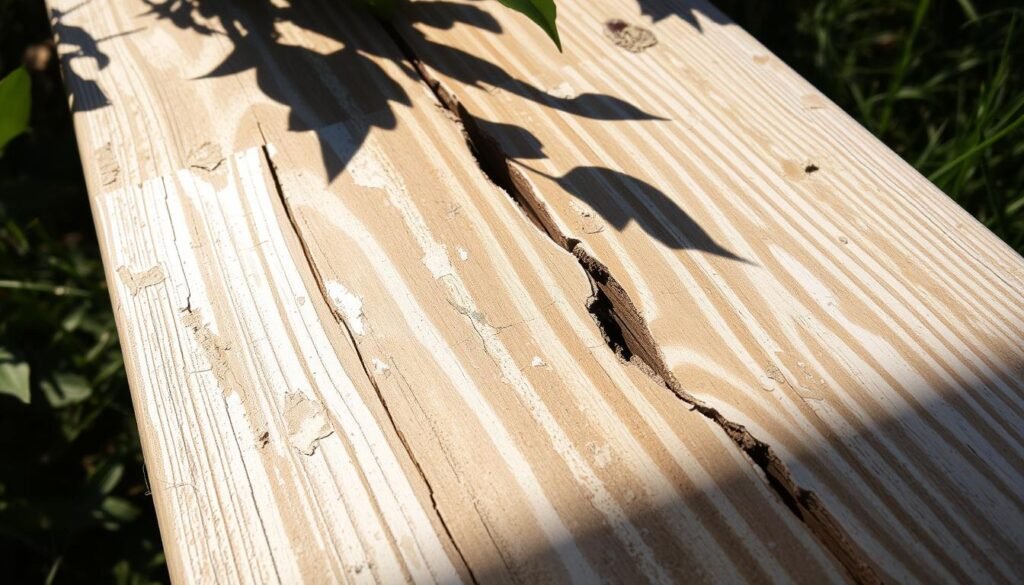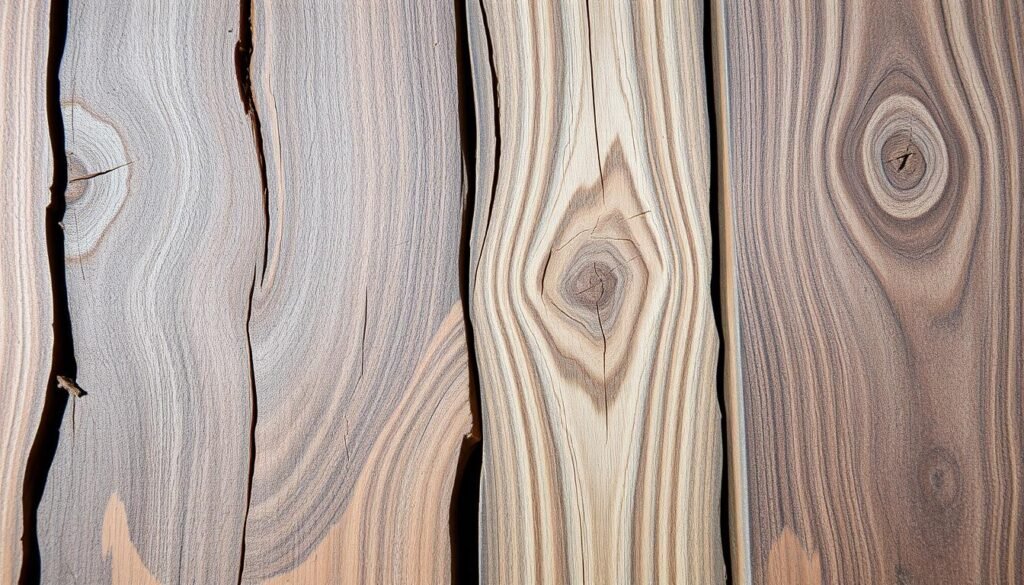Imagine a serene beach house with weathered wooden siding shining in the sun. But beneath its charming look, this house fights a constant battle against nature. It’s a common problem for homeowners and builders who work with wood.
But wood isn’t the only material that can suffer damage. Plastics can fade and crack from UV rays. Metals can rust and corrode from moisture and salt air. Knowing how different materials can be damaged helps keep them looking good for longer.
Understanding the Causes of Wood Damage
Sunlight is a big problem for wood. The UV rays in sunlight can harm the wood’s lignin. This is called photo-oxidation of wood. It can make the wood lose its shine, turn chalky, and change color over time.
The finish on the wood also matters a lot. Opaque finishes like paint and solid body stains block UV light well. But transparent stains let more UV light in, causing the wood to deteriorate slowly.
Moisture and Humidity
Wood in coastal areas faces another big challenge: wood damage from moisture. Coastal areas have high humidity and lots of thunderstorms. It’s important to keep wood dry to protect it.
If wood stays wet for too long, it can get damaged by wood decay fungi. This leads to wood rot. To prevent this, it’s crucial to know the right conditions for fungi growth.
Four things help fungi grow: oxygen, the right temperature (40°F – 90°F), and moisture (more than 25-30%). They also need energy and nutrients from the wood itself. Knowing these factors for wood decay helps prevent and fix wood rot.

How Wood Materials Respond to Moisture Exposure
Wood changes size and how well fasteners hold when it gets wet. The amount of moisture in the wood affects how well it works and lasts.
Wood stays strong and fasteners work best when it’s between 8-14% moisture. But, if it gets too wet, things change. Fasteners can lose a lot of strength, especially when moisture goes over 30%.
OSB swells up to 50% when it gets wet. But, pressure-treated pine changes the least. This shows picking the right wood for the job is key, especially when it comes to moisture.
| Wood Moisture Content | Fastener Strength | Dimensional Changes |
|---|---|---|
| Less than 8% | Highest | Minimal |
| 8-14% | Optimal | Moderate |
| More than 30% | Lowest | Significant (up to 50% for OSB) |
Knowing how wood reacts to moisture is key for choosing the right materials. It helps ensure wood products last a long time. Keeping wood dry during use and care is important to avoid problems.

Materials that become damaged like wood
Wood is not the only material that can get damaged. Paper-based artworks, heirlooms, and other materials can also face similar problems. It’s important to know how different materials can be damaged to help preserve them.
Non-Archival Materials and Improper Framing
Using non-archival, acidic materials in framing can harm sensitive items. These materials can cause discoloration and damage. UV light can make things worse, leading to fading and darkening.
Bad framing, like using the wrong matboards and glazing, can also damage items. Experts suggest using archival-quality materials and methods to protect these treasures.
- Non-archival, acidic materials in framing and storage can lead to “acid burn” and deterioration of artwork and heirlooms.
- UV light exposure can cause fading and darkening of sensitive materials.
- Improper framing techniques, such as the use of non-archival matboards, hinges, and backing boards, can further damage delicate items.
- Conservators advise the use of archival-quality materials and framing methods to protect artwork and heirlooms.
Conclusion
Protecting wood and other materials from damage is key. Keeping them away from sunlight and maintaining the right humidity is important. This helps prevent warping, discoloration, and mold.
Using the right finishes and coatings can also help. These products add an extra layer of protection to wooden surfaces.
For items like framed artworks and heirlooms, special care is needed. Using UV-filtering glazing and acid-free matboards is crucial. Secure hanging hardware also plays a big role in preserving these items.
Regular checks and maintenance are vital. They help catch and fix problems early on. This way, valuable items stay in good condition for a long time.
By following these steps, we can keep our precious belongings safe. This ensures they remain beautiful and valuable for many years. Taking good care of these items also helps preserve their cultural and historical value.